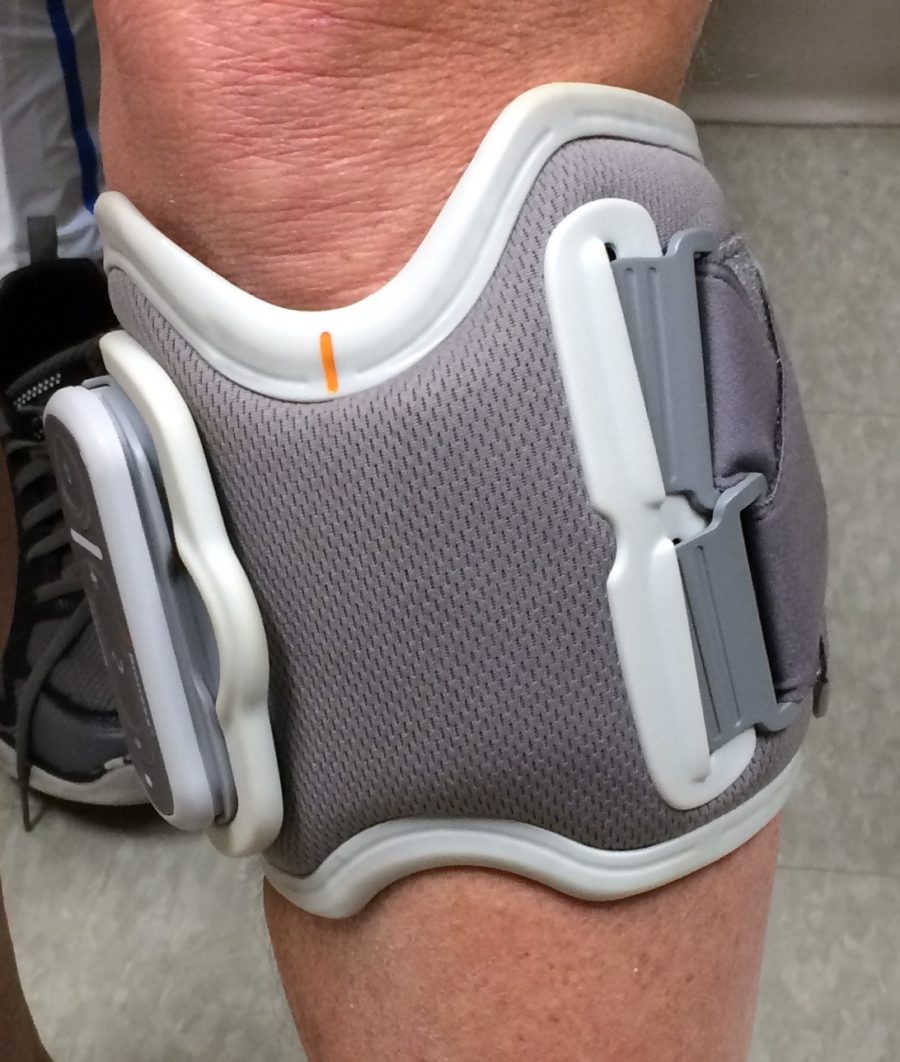I’ve used the Bioness L300, a functional electrical stimulator (FES) device, for about seven years to counter my left foot drop. It’s strapped to my leg just below the knee and, as I began to take a step, it sends a low-intensity electrical pulse down a nerve that triggers my foot to flex upward, so my toes don’t drag. The L300 has worked well for several years. But, as my multiple sclerosis has progressed it’s become less useful and, frankly, more of a nuisance than a help. Yet, it’s been better than nothing.
In the Fall of 2017, Bioness came out with an improved FES called the L300 Go. I took it for a test walk just before it became available to patients, and, as I wrote in a post, I was disappointed with the results. I didn’t think the improvement in my walking was worth the several thousand dollars — not covered by insurance — that it would cost me to upgrade. But that was then, and this is now.
The L300 Go gets a second chance
Several weeks ago, I met with a Bioness physical therapist and tried the L300 Go again. This time I decided to bite the financial bullet and upgrade. Here’s why:
Bioness is getting ready to end support for the original L300. When I first tried the Go in 2017, I was told that the company would phase out support in about two years. We’re coming up on 2020, so the old unit was living on borrowed support time.
My old unit wasn’t performing as well as it once did. It wasn’t simply a case of my MS advancing; the old cuff was becoming more difficult to position correctly on my leg to get the correct amount of stimulation. It was also a real pain to have to move the little plastic disc, positioned under my shoe’s insole to sense motion, from one pair of shoes to another. The L300 Go doesn’t require that sensor as my leg motion is now detected by the cuff itself.

The latest L300 has a three-axis gyroscope and an accelerometer that combine to sense motion in several directions as well as my leg speed. It also has a memory that “learns” how I walk. According to the Bioness website, that allows it to provide “stimulation precisely when needed making it easier for users to clear their foot at different walking speeds, on stairs, ramps, and while navigating uneven terrain.”
The L300 Go also no longer requires a remote controller. The controls live on the cuff. Or, you control the unit with a smart phone app. That, optional, app will also track your steps and allow you to set the Go into a cycling mode, so you can use the cuff while riding a stationary bike. But this app will cost you an additional $25. Are you kidding me??? Bioness has some gall charging an extra 25 bucks when they’re already getting around $6,000 for the unit itself. More on the cost, shortly.
The proof is in the walking
I’ve been using the L300 Go for about a month, and the headline is that I’m walking better with it than I did with my old unit. But it’s taken some getting used to. The old unit would trigger on and begin to raise my foot as I removed pressure from the sensor at my heel. With the new unit, the movement of my leg triggers the current. So, the current remains on for longer, until my left leg is straight, rather than ending when my heel hits the ground. At first, I found this to be disconcerting but, after a couple of weeks, I got used to it and found that this allowed me to walk better. And the gyroscope and accelerometer do capture my gait and pace and adjust for it. My left leg swings out to the left much less than it used to and my legs are less prone to cross. It’s also easier to lift my left leg up onto a curb.
Get out your checkbook
The L300 Go isn’t inexpensive. With a trade-in of my old L300, my cost was just over $4,000. I think the full price is around $6,000. And there’s a continuing cost for replacing the units electrodes. Most commercial insurance plans won’t cover the L300 Go for an MS patient, and Medicare definitely won’t. (I don’t know if the health services in the United Kingdom or the European Union do). Bioness has an arrangement with the CareCredit system for a no-interest payment plan if you qualify. But in the end, you’re still shelling out big bucks.
I’m fortunate that I can afford it and I realize that many people who need this useful device can’t. When I received my original L300 I got a used unit from Bioness at half price, but a company rep has told me that the program no longer exists. That’s too bad. It’s also a shame that Medicare, though it covers the L300 Go for someone with a spinal injury, won’t cover it for a person with MS. I doubt that the situation will change anytime soon. Don’t get me started on healthcare costs in the United States. That’s a subject for many other posts.
(A version of this post first appeared as my column on the MS News Today website).



